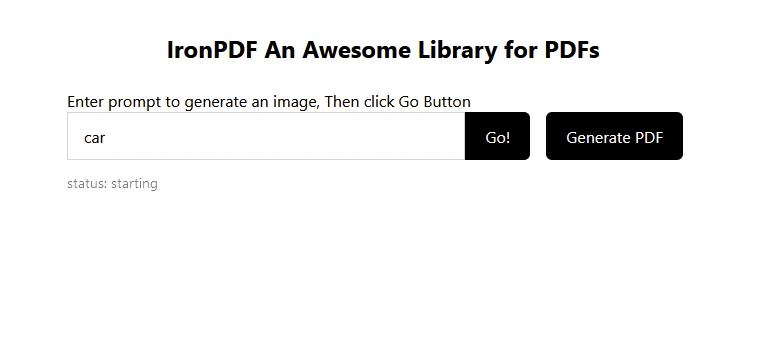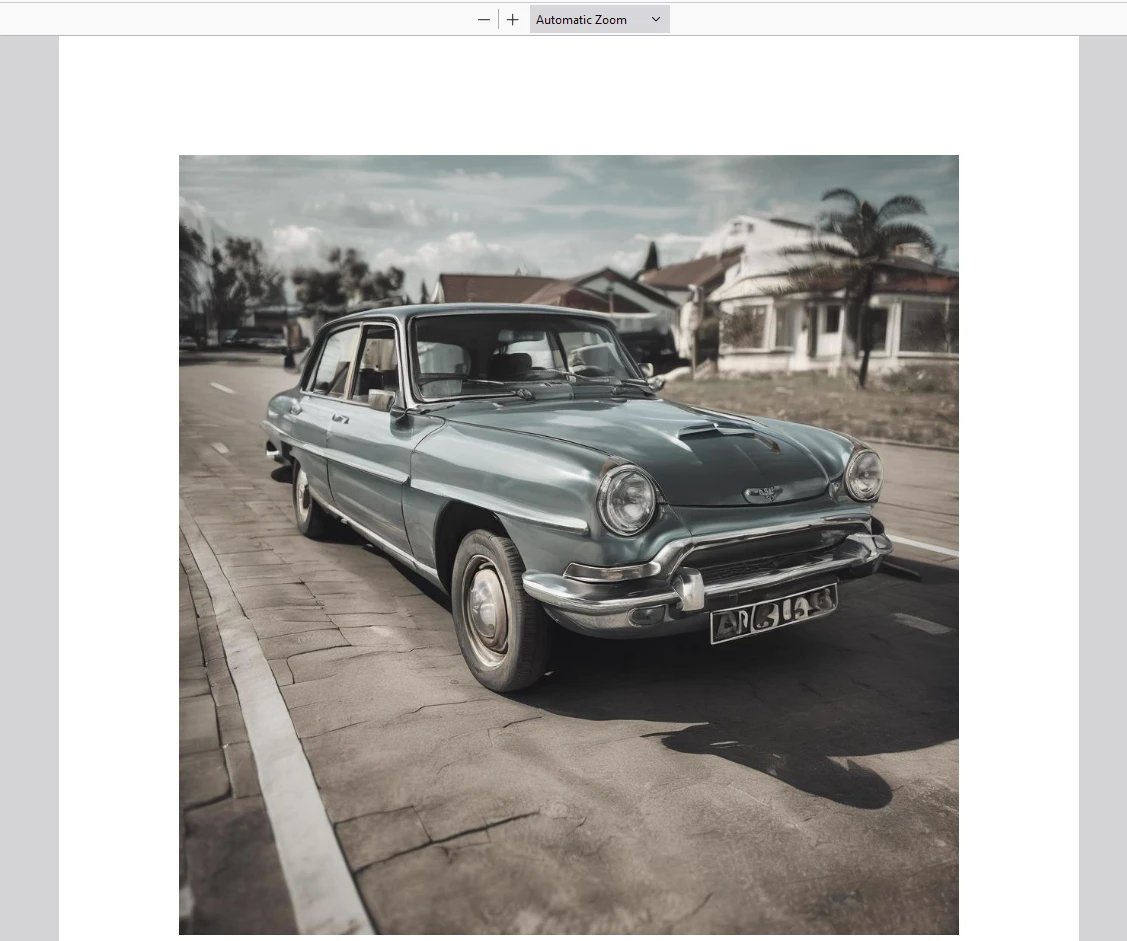Test in production without watermarks.
Works wherever you need it to.
Get 30 days of fully functional product.
Have it up and running in minutes.
Full access to our support engineering team during your product trial
The 'replicate' NPM package is a powerful client tool for integrating machine learning models to React applications. It allows developers to easily use pre-trained models and run inferences directly within their applications without needing to manage complex backend infrastructure. Here's an overview of how you can use the replicate NPM package in your React project. Also, we will look into IronPDF, a PDF generation library to generate PDF and combine both the libraries to create a working application.
Replicate is an online platform that provides access to machine learning models through a simple API. It hosts models from various domains, such as image generation, text analysis, and more. By using the 'replicate' NPM package, developers can seamlessly integrate these models into their applications.
To use `replicate` in your React application, you first need to install the package. You can do this using npm or yarn:
npm install replicateor
yarn add replicateYou will need an API key to interact with the Replicate API. You can obtain this key by signing up on the Replicate website and creating a new API token.
Here's a step-by-step guide to using the `replicate` package in a React application.
import Replicate from 'replicate';
const output = new Replicate({
auth: 'YOUR_API_TOKEN'
});Assuming you want to use a model to generate an image from text, with just a few lines of code you get the result as below:
const result = await replicate.run("stability-ai/stable-diffusion", {
input: {
prompt: "a futuristic cityscape"
}
}); // identifier and prediction parameters
console.log(result);Let's create a simple React application that allows users to generate images based on text prompts to demonstrate node replicate usage.
npx create-react-app replicate-example
cd replicate-example
npm install replicateimport React, { useState } from 'react';
import Replicate from 'replicate';
const replicate = new Replicate({
auth: 'YOUR_API_TOKEN'
});
const ImageGenerator = () => {
const [prompt, setPrompt] = useState('');
const [image, setImage] = useState(null);
const generateImage = async () => {
const result = await replicate.run("stability-ai/stable-diffusion", {
input: { prompt }
});
setImage(result.output[0]);
};
return (
<div>
<h1>Image Generator</h1>
<input
type="text"
value={prompt}
onChange={(e) => setPrompt(e.target.value)} // const input
placeholder="Enter a prompt"
/>
<button onClick={generateImage}>Generate Image</button>
{image && <img src={image} alt="Generated" />}// prediction object
</div>
);
};
export default ImageGenerator;import React from 'react';
import ReactDOM from 'react-dom';
import './index.css';
import App from './App';
import ImageGenerator from './ImageGenerator';
ReactDOM.render(
<React.StrictMode>
<App />
<ImageGenerator />
</React.StrictMode>,
document.getElementById('root')
);When working with APIs, it's crucial to handle errors gracefully. You can modify the 'generateImage' function to catch and display errors:
const generateImage = async () => {
try {
const result = await replicate.run("stability-ai/stable-diffusion", {
input: { prompt }
});
setImage(result.output[0]);
} catch (error) {
console.error("Error generating image:", error);
alert("Failed to generate image. Please try again.");
}
};IronPDF is a versatile npm package designed to simplify PDF generation in Node.js applications. It allows you to create PDF documents from HTML content, URLs, or existing PDF files. Whether you need to generate invoices, reports, or other types of documents, IronPDF makes the process easy with its intuitive API and comprehensive feature set.
Easily convert HTML content into PDF documents, perfect for generating dynamic PDFs from web content.
Create PDFs directly from URLs, enabling you to capture web page content and save it as PDF files programmatically.
Merge, split, and manipulate existing PDF documents with ease. IronPDF provides functionalities for appending pages, splitting documents, creating PDF forms, and more.
Secure your PDF documents by encrypting them with passwords or applying digital signatures, protecting your sensitive documents from unauthorized access.
Produce high-quality PDF documents with accurate rendering of text, images, and formatting, ensuring the generated PDFs remain true to the original content.
IronPDF's compatibility with Windows, Linux, and macOS, makes it suitable for various development environments.
Integrate IronPDF into your Node.js applications easily using its npm package. The well-documented API simplifies incorporating PDF generation capabilities into your projects.
Whether you’re developing a web application, a server-side script, or a command-line tool, IronPDF empowers you to create professional-grade PDF documents efficiently and reliably.
Install Dependencies: First, create a new Next.js project (if you haven’t already) using the following command: Refer here
npx create-next-app@latest replicate-pdf --use-npm --example "https://github.com/vercel/next-learn/tree/main/basics/learn-starter"Next, navigate to your project directory:
cd replicate-pdfInstall the required packages:
yarn add @ironsoftware/ironpdf @ironsoftware/ironpdf-engine-windows-x64
yarn add replicateCreate a PDF: Now, let’s create a simple example of generating a PDF using IronPDF. In your Next.js component (e.g., pages/index.tsx), add the following code:
PDF Generation API: First step is to create a backend API to generate the PDF document. Since IronPDF only runs server side, we need to create an API to call when users want to generate PDF. Create a file in path pages/api/pdf/route.js and add below contents:
// pages/api/pdf.js
import { NextRequest, NextResponse } from 'next/server';
import {IronPdfGlobalConfig, PdfDocument} from "@ironsoftware/ironpdf";
// Apply your IronPDF license key
IronPdfGlobalConfig.getConfig().licenseKey = "your key";
export const GET = async (req) => {
const {searchParams} = new URL(req.url);
const name = searchParams.get("url");
try {
const pdf = await PdfDocument.fromUrl(name);
const data = await pdf.saveAsBuffer();
console.error('data PDF:', data);
return new NextResponse(data, {
status: 200,
headers: {
"content-type": "application/pdf",
"Content-Disposition": "attachment; filename=awesomeIron.pdf",
},
})
} catch (error) {
console.error('Error generating PDF:', error);
return NextResponse.json({ detail: "error" }, { status: 500 });
}
}IronPDF requires a license key, which you can get it from the license page and place in the above code
Add the below code to index.js
'use client';
import { useState, useEffect, useRef } from "react";
import Image from "next/image";
const sleep = (ms) => new Promise((r) => setTimeout(r, ms));
export default function Home() {
const [prediction, setPrediction] = useState(null);
const [error, setError] = useState(null);
const promptInputRef = useRef(null);
useEffect(() => {
promptInputRef.current.focus();
}, []);
const handleSubmit = async (e) => {
e.preventDefault();
const response = await fetch("/api/predictions", {
method: "POST",
headers: {
"Content-Type": "application/json",
},
body: JSON.stringify({
prompt: e.target.prompt.value,
}),
});
let prediction = await response.json();
if (response.status !== 201) {
setError(prediction.detail);
return;
}
setPrediction(prediction);
while (
prediction.status !== "succeeded" &&
prediction.status !== "failed"
) {
await sleep(1000);
const response = await fetch(`/api/predictions/${prediction.id}`);
prediction = await response.json();
if (response.status !== 200) {
setError(prediction.detail);
return;
}
console.log({ prediction });
setPrediction(prediction);
}
};
const generatePdf = async () => {
try {
const response = await fetch("/api/pdf?url=" + prediction.output[prediction.output.length - 1]);
const blob = await response.blob();
const url = window.URL.createObjectURL(new Blob([blob]));
const link = document.createElement("a");
link.href = url;
link.setAttribute("download", "awesomeIron.pdf");
document.body.appendChild(link);
link.click();
link.parentNode.removeChild(link);
} catch (error) {
console.error("Error generating PDF:", error);
}
}
return (
<div className="container max-w-2xl mx-auto p-5">
<h1 className="py-6 text-center font-bold text-2xl">
IronPDF An Awesome Library for PDFs
</h1>
<p>Enter prompt to generate an image, Then click </p>
<form className="w-full flex" onSubmit={handleSubmit}>
<input
type="text"
className="flex-grow"
name="prompt"
placeholder="Enter a prompt to display an image"
ref={promptInputRef}
/>
<button className="button" type="submit">
Go!
</button>
<button className="pdfButton" type="button" onClick={generatePdf}>
Generate PDF
</button>
</form>
{error && <div>{error}</div>}
{prediction && (
<>
{prediction.output && (
<div className="image-wrapper mt-5">
<Image
fill
src={prediction.output[prediction.output.length - 1]}
alt="output"
sizes="100vw"
/>
</div>
)}
<p className="py-3 text-sm opacity-50">status: {prediction.status}</p>
</>
)}
</div>
);
}The code begins by importing necessary modules from external libraries: 'useState', 'useEffect', and 'useRef' from "react": These are React Hooks that allow function components to manage state, handle side effects, and create references to DOM elements, respectively.
'Image' from "next/image": This is a component provided by Next.js for optimized image loading. The "use client" statement is not a standard JavaScript or React import. It appears to be specific to Next.js (a React framework) and indicates that the component using it should be rendered on the client side. It ensures that the necessary JavaScript for that component is sent to the client.
The 'Home' component is defined as the default export. Inside the component, there are several state variables ('prediction', 'error') managed using the 'useState' hook.
A reference ('promptInputRef') is created using the 'useRef' hook. The 'useEffect' hook is used to focus on the 'promptInputRef' when the component mounts.
The 'handleSubmit' function is an asynchronous function that handles form submission. It sends a POST request to an API endpoint (`/api/predictions`) with a prompt value.
The response is processed, and if successful, the 'prediction' state is updated. The function then enters a loop, periodically checking the prediction status until it succeeds or fails. The 'generatePdf' method fetches a PDF from another API endpoint (`/api/pdf`) based on the last output in the 'prediction' state.
The component returns a container div with some styling ('max-w-2xl', 'mx-auto', 'p-5'). Inside the container, there is an '
Overall, this code appears to be part of a Next.js application that handles predictions and generates PDFs based on user input. The "use client" statement is specific to Next.js and ensures client-side rendering for the component where it's used. If you have any specific questions about a particular part of the code

Enter text for prediction as "car" then below image is predicted

Then click on Generate PDF to create a PDF document

IronPDF page.
Place the License Key in the app as shown in the following example:
import {IronPdfGlobalConfig, PdfDocument} from "@ironsoftware/ironpdf";
// Apply your IronPDF license key
IronPdfGlobalConfig.getConfig().licenseKey = "Add Your key here";The `replicate` NPM package provides a convenient way to leverage powerful machine learning models to React applications. By following the steps outlined in this article, you can easily integrate image generation capabilities into your projects. This opens up a wide range of possibilities for creating innovative and interactive user experiences.
Remember to explore other models available on the Replicate platform to expand the functionality of your applications further.
Also, IronPDF is a powerful PDF library for PDF generation and manipulation features, along with the ability to render responsive charts in PDFs on the fly. It enables developers to integrate feature rich chart packages into apps in just a few lines. Together with these two libraries, developers can work with modern AI technology and save the results reliably in the form of PDFs.